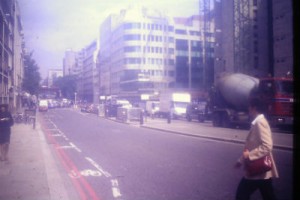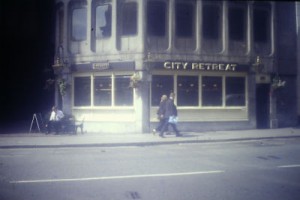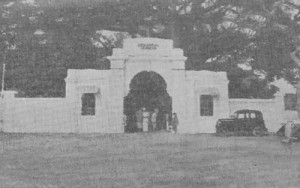Registered with the Registrar of Newspapers for India under R.N.I 53640/91
Vol. XXVI No. 06, July 1-15, 2016
Our readers write
Did Mahatma Gandhi and Sherlock Holmes ever meet?
 Faringdon Street , present day.
Faringdon Street , present day.
 Where ‘The Central’ was.
Where ‘The Central’ was.
Kumaran Sathasivam’s well-researched piece on Sir Arthur Conon Doyle’s, and by association Sherlock Holmes’s, Indian connection (MM, June 16), takes my mind back to nearly 15 years when Ranjitha Ashok wrote what was perhaps the first article ever on Sherlock Holmes to appear in MM (September 1, 2001). It was about a 30-member strong ‘Sherlock Holmes Society of Madras’, founded in the late 1970s by my elder brother, the late Dr. G. Krishnamurthi (‘Kittu’ to family and friends). A month later, the Editor of MM himself wrote about the ‘Society’ in his ‘Madras Miscellany’ column in The Hindu. Reading all those write-ups on Sherlock Holmes, one question used to intrigue me in those days and still does.
Did Mahatma Gandhi and Sherlock Holmes ever meet?

Let me clarify matters – Kittu and his fellow members of the Sherlock Holmes Society of Madras, in common with members of Sherlock Holmes Societies the world over, liked to pretend that Sherlock Holmes was a historic figure who had lived in flesh and blood. It was a make believe world they had built out of their great love for the fictional detective. At their meetings they would, for example, hold serious discussions on an issue like why Holmes was not knighted, or whether Holmes had ever watched W.G. Grace bat at Lords. Kittu had taken these pretensions a step further, and had his own ‘precious collection’ of Sherlock Holmes memorabilia, like “a deer-hunter’s cap that was once used by Holmes”, “a clay pipe smoked by Holmes”, “a Stradivarius violin from Holmes’s collection” and so on. On those few occasions when I attended the Madras Society’s meeting, I too would join in their eccentric pastime.
But my interest in Sherlock Holmes was at best a passing interest. My own special interest, then as now, has been the life and times of Mahatma Gandhi. Kittu had just a low key interest in the life of the Mahatma. It was not even a small fraction of the passion he felt for the Sherlock Holmes stories. But he was not averse to carrying on with me, once in a while, some small talk on the life of Gandhiji.
One evening, over a cup of coffee, I was telling Kittu about the mesmerising effect Gandhiji appeared to have had, even as a young man, on people when they first met him face to face. There was the case of a ship’s captain in 1893, an Englishman, who invited young Mohandas Gandhi, a total stranger till then, to share the extra berth in his cramped cabin, on the long voyage from Bombay to Durban. There was no other room on board the overcrowded ship, and all that it took the Captain was a “survey from top to toe” of the young Indian standing in front of him, before he decided to give him a berth in his cabin. So also, when Rev. C.F. Andrews was introduced to young Gandhi in Durban harbour in 1914. The Englishman quietly bent down and touched the Indian’s feet. When I was telling Kittu all this, he suddenly turned to me, looked me straight in the eye, and asked: “Did Gandhi ever meet Sherlock Holmes?”.
I was struck dumb by the very absurdity of the question and did not answer immediately. But knowing my brother as I did, I decided to go along.
“No, not to my knowledge,” I replied, “but it appears very unlikely”.
“I wouldn’t say that,” remarked Kittu. “As you know, the lives of both Gandhi and Sherlock Holmes are very well chronicled – Gandhi’s by his innumerable biographers, and Holmes’s by Dr. Watson. Gandhiji made many trips to London; and he was there as a student during the last decades of the 19th Century when Holmes was very active in his profession. If Holmes had met young Gandhi at that time, he would have certainly deduced that the young Indian student had all the makings of a man destined to change the course of world history. Such was Holmes’s extraordinary powers of perception.”
Kittu said all this with a straight face, without as much as even a hint of a smile. I had great difficulty in restraining myself from bursting into laughter. I permitted myself just an amused smile and said,
“I have not come across any accounts of Gandhiji taking strolls around Baker Street.”
Kittu gave me an annoyed look. There our conversation ended and within a few days, memories of the whole episode vanished into some recess at the back of my mind.
Many months later, I was on a long train journey from Bombay to Bangalore, when I chanced to see a volume of Adventures of Sherlock Holmes with a co-passenger. He had apparently finished with it. With his permission I picked it up and started lazily browsing through. They were all short stories that I had read many years ago in my college days. I no longer remembered the stories, but many of the titles had remained in my memory. There was the story titled ‘The Red-headed League’ which I vaguely remembered to have found very interesting when I first read it. I started reading it again. (For readers who might be interested, a summary of the story is available in Wikipedia)
I came to the part of the story where Holmes in the company of Watson is noseying about the business premises of his client, one Jabez Wilson, a pawnbroker. It is afternoon, and the location is Saxe-Coburg Square in Central London. Holmes walks up and down the street, then inexplicably thumps the road pavement in front of his client’s shop with his walking stick. He then enters the shop and makes some small talk with the shop assistant. Back on the street, he walks around the corner of the square, and they enter a busy thoroughfare. Holmes then calls out to Watson the order of the houses on the street as they pass them – beginning with the tobacconist, then a newspaper shop, the local branch of the ‘City and Suburban Bank’ , the vegetarian restaurant and finally a carriage-building depot. Apparently satisfied with what he had seen, Holmes finally takes Watson for a cup of coffee and a sandwich.
This is the substitute for the lunch they had planned to have on the way, but had to skip for want of time.
Even as I was reading, I felt a slight stir in my mind at the mention of a vegetarian restaurant in Central London. I paused for a moment and read on. Holmes and Watson spend the rest of the afternoon at a concert. Later, in the evening, they return to the same thoroughfare with adequate police and make a big catch of bank robbers in the vault of the City and Suburban Bank. This time Watson gives the name of the thoroughfare. It is Farringdon Street.
A vegetarian restaurant in Farringdon Street! That rang a bell! As soon as I returned home, the first thing I did was to flick through my well-thumbed copy of Gandhiji’s Autobiography. And there it was in Part I/ Chapter XIV. The vegetarian restaurant in Farringdon Street was the first vegetarian eating place that young Mohandas Gandhi the student had ‘discovered’ in London as he was wandering around with insatiate hunger in search of a place where he could get a decent vegetarian meal. “The sight of it [the vegetarian restaurant]”, he writes, “filled me with the same joy that a child feels on getting a thing after its own heart”. Thus it was that I had come across a link between Sherlock Holmes’s London and Mahatma Gandhi’s London , quite by accident, without much effort on my part.
But many loose ends remained to be tied up before I would know whether the two had actually met on Farringdon Street on that fateful afternoon, and I could get answer to Kittu’s question. The day and date of the occurrence is given in the story. It was Saturday, October 20, 1890. By then Gandhiji had spent over two years in London. He was preparing for the ‘Bar Finals’, the last examination to pass before he qualified as a barrister. This much information could be gathered from his Autobiography.
I collected more details on Gandhiji’s life during that period. The booklet he wrote in 1893, titled Guide to London, and James D. Hunt’s well-researched book Gandhi in London came in handy. As could be conjectured from the Guide, Gandhiji prepared his own vegetarian breakfast and had it in his room before he ventured out for the day. He would have his lunch at a vegetarian restaurant. James D. Hunt names ‘The Central’ as one of his favourite vegetarian restaurants, and it was at 16, Saint Bride Street, off Farringdon Street and facing it.
It is certain that Gandhiji would have been in the vicinity of ‘The Central’ on Farringdon Street the time Sherlock Holmes passed that way just before lunch time on October 20, 1890. Their paths must have crossed, and they must have, at least for a moment , been face to face. It is even likely that Holmes and Watson had their sandwich and coffee at ‘The Central’ and had sat at a table close to where Gandhiji was having his lunch. The question is whether Holmes, with his extraordinary powers of deduction, had deduced that he was face to face with a man destined to change the course of history. And equally important to me, did the Englishman feel a compulsive urge to bend down and touch the Indian’s feet?
There was one man in Madras who could have possibly answered these questions for me. But, alas, by the time I had my background information ready, the founder of ‘The Sherlock Holmes Society of Madras’ was no more.
G. Ram Mohan
visalam.rammohan@gmail.com
The right entrance
In Madras Musings, June 1st, there was with the Zoo story, a photo of ‘The entrance to the zoo at People’s Park’. But this was not the entrance of that zoo. I was in-charge of shifting the old Chennai zoo to Vandalur. The correct picture of the entrance to the People’s Park zoo is shown in the picture above.
S. Subbarayalu, ifs (retd)
25, West St. Kilpauk Garden Colony
Chennai 600 010

